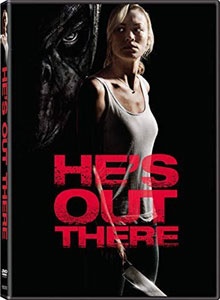Similar to the two “Strangers” films, “He’s Out There” (2018, now on Netflix) strips the horror genre down to basics and tells a scary story of people in random peril at a remote cabin. It plays the requisite horror notes well, includes one moment that literally made me flinch, and offers a touch of mystery to keep a viewer wondering about the villain’s motivations. And while I wasn’t bored by the film, I knew I had Yvonne Strahovski to look at if the plot ceased to hold my interest.
This is one of those calling-card horror films, where I’m not surprised to look up the writer (Mike Scannell) and director (Quinn Lasher) on IMDB and find out this is their first major project. The genre is ideal for showcasing basic talent without a big budget.
“Chuck” veteran Strahovski plays Laura, who drives out to the family lake cabin with her two young daughters, Kayla and Maddie (Anna and Abigail Pniowsky). The dad, Shawn (Justin Bruening), plans to follow later that day after a work meeting in the city. “He’s Out There” is a one-actress show for most of its running time, and while Strahovski is too far into her career to need a calling card herself, she is good in the role – doing many scenes by herself or with the two youngsters, who are essentially props.
Some of “He’s Out There” is predictable but enjoyable in the manner of “Cool! I guessed that would happen!” And some of it is not quite predictable – the villain pulls off a neat trick with a cellphone – but it’s not entirely satisfying in its payoff.
The conceit of the “Strangers” films is that there’s no reason for the killers to stalk the innocent victims – something that harkens back to the original “Halloween” and makes them different from the majority of horror films.
“He’s Out There” isn’t stripped down to that degree, but nor does it go much into the backstory of the masked stalker after dropping some vague hints. Scannell bookends the film with a child’s voiceover about the manifestation of darkness, and while it’s not out of place, it’s also not insightful. Being in this middle ground keeps the film from reaching an elite level. It ultimately doesn’t have a hook that makes it stand out – like how “Hush’s” target is deaf, for example.
Still, Lasher shows thorough competence at the basics of ratcheting up tension, and I also enjoy the muted color palette from Ed Wild and the score by Nathan Whitehead. It’s ominous enough to suggest nuances to Scannell’s screenplay that, in the end, might not really be there.

